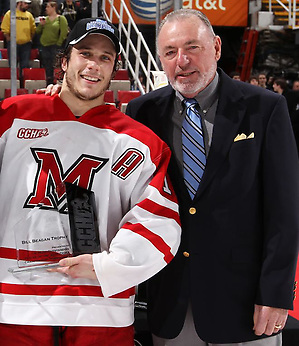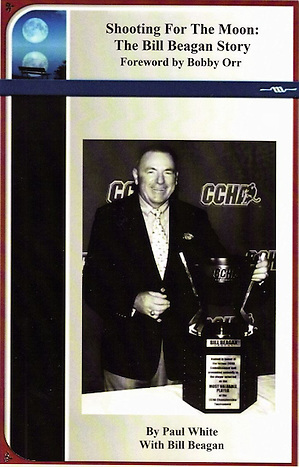Editor’s note: This is the second of an occasional series of stories checking in with college hockey personalities, past and present.
Bill Beagan was commissioner of the CCHA during a period of growth in the 1980s and is credited with coining the phrase “Road to the Joe” in describing the league playoffs.

Now retired from hockey, Beagan, also a former NHL referee, is the subject of a new book: “Shooting for the Moon: The Bill Beagan Story.”
Beagan recently took time to chat with USCHO about his book, what else he has been doing, why he retired and how he sees the college hockey landscape shaping up in the future.
USCHO: What have you been up to since your CCHA days? Family time? Other hockey projects?
BB: Actually, I spend a lot of time wondering why I chose to retire. Ultimately, I came to the conclusion that my pride had a lot to do with my decision to leave the CCHA, such as no longer being able to scamper up the elevation of steps to the respective press boxes, two steps at a time, principally because of two hip replacement surgeries, and a degenerative disc in my lower back.
I tell everyone who cares to listen to never even consider retirement if you like what you are doing, and not embarrassing yourself. Frankly, retirement is overrated.
More to the point, I’m involved in charitable fundraising connected with military projects for veterans, perfecting my skills as a vintner of fine wines, and mentoring our two grandchildren, both of whom I consider potential NCAA D-I hockey players. I participate in a winter golf league and enjoy bicycling on the pristine beaches of South Carolina during the five months [his wife] Barbara and I winter on Hilton Head Island.
USCHO: How did the book go from an idea in your head to reality?
BB: When I retired, I wrote my memoirs with the explicit intention of giving a copy to my son and daughter and two grandchildren. At the time, that was it.
In 2008, however, a writer (Paul White) was assigned to write a piece about me for a publication called Sideroads of Parry Sound & Area. Following its publication, the author contacted me and asked if I would permit him to write my biography. I eventually agreed and for the next two years, Paul and I enjoyed our back-and-forth-chats and ultimately, after several hours fiddling with and massaging the manuscript, it finally transitioned into book form.
USCHO: Without spoiling too much, what can we expect in the book?
BB: As the readers travel through the pages of the book, they will discover passages and information supplied by many individuals including, but not limited to, former NHL president John Ziegler Jr., USA Hockey president Ron DeGregorio, former Chicago Blackhawks owner William “Bill” Wirtz, former NHL superstar Bobby Orr, chairman of the Hockey Hall of Fame and former NHL referee-in-chief “Scotty” Morrison, Hockey Hall of Fame broadcaster Mike “Doc” Emrick, former NHL referee Kerry Fraser, Miami associate AD Steve Cady, Western Michigan faculty representative Dr. Adrian “Ed” Edwards, former CCHA commissioner and current Michigan State head coach, Tom Anastos, Michigan head coach Red Berenson, former Michigan AD Don Canham, Hockey Night in Canada executive producer Ralph Mellanby and author John U. Bacon.
The book also delves into my childhood, my 13-year military service, my time as an NHL referee, tenures as commissioner of the IHL, OHL, EHL and CCHA and time as owner and GM of the Toledo Goaldiggers of the IHL.
USCHO: What is your take on all the future college hockey realignment, especially seeing the CCHA essentially going away in two years?
BB: I don’t necessarily agree with your implication that the CCHA is somehow “going away.” Having expressed this optimistic point of view, I should point out that we live in an ever-evolving and dynamic society, the manifestation of which is that we create new problems as quickly as we solve the old ones. For example, 45 years ago there were only four teams from the United States in the NHL and not one of these teams west of Chicago. Presently, there are 24 NHL teams from the U.S. stretching from coast to coast.
The unprecedented and clearly unanticipated confusion connected with the pending realignment of various universities connected with NCAA D-I college hockey, particularly those programs from within the CCHA and WCHA, is a huge concern and I wouldn’t even speculate how the affected programs will be aligned in terms of future conference configurations. Hopefully, when all the dust settles, all existing programs which currently constitute the CCHA and WCHA will remain viable, assuming there is the spirit and will to make this happen.
It was inevitable that the Big Ten would establish an autonomous NCAA D-I college hockey conference once a sixth team [Penn State] announced the creation of a D-I hockey program. I envision the Big Ten hockey conference expanding exponentially in what I envision another two, and perhaps four additional programs, possibly including Notre Dame, by the time they officially launch their Big Ten college hockey conference. Just makes sense.
The Big Ten television network will eventually outshine ESPN, in my opinion, in terms of college sports coverage on television, and being as we live in a money-driven culture, by Notre Dame joining the Big Ten Conference they [Notre Dame] reportedly would increase their annual television revenue three-fold to what it is presently.
The ECAC and Hockey East are solidly constituted, well administrated, and I don’t hear any alarm bells emanating from the East.
USCHO: From an administrative standpoint, how have you seen the college hockey landscape change since you were with the CCHA?
BB: Well, other than the emergence of women’s hockey, which I am extremely excited about, in terms of the CCHA, WCHA, ECAC and Hockey East, the status quo of these four principal conferences remains pretty much as they were constituted when I retired 13 years ago. Nebraska-Omaha left the CCHA for the WCHA and Bemidji State and Minnesota State were accepted into the WCHA for a net increase of just two programs in the entire NCAA D-I hockey constituency. So the “hockey landscape,” as I view it, is essentially the same as it was when I retired in 1998.
USCHO: What are some of your fondest memories from your time with the CCHA?
BB: The first thing that comes to my mind in terms “fondest memories” is the pleasant working environment, refreshing academic culture, and constructive social intercourse I had with individuals who I could actually sit down with and objectively converse with in a non-combative setting. Individuals like Michigan’s ADs Don Canham, MSU’s AD Doug Weaver, BGSU’s AD Jack Gregory, Miami’s AD Dick Shrider and LSSU’S AD “Bud” Cooper come to mind as gentlemen, and college hockey visionaries, whom I was very proud to be connected with.
Keep in mind that I came directly from the International Hockey League to the CCHA. I was owner and GM of the IHL’s Toledo Goaldiggers hockey team. Players were actually known to pull a groin on a bus trip to road games, fearing the thought of having to skate on the ice in a hostile visiting arena. Frankly, attending my first CCHA council meeting was like coming from a ruckus Roman coliseum to a meeting of Christian missionaries.
Seriously, the CCHA college hockey constituency was always agreeable and receptive to any input that would increase the exposure and improve acceptability and viability of the college hockey game.
Chief among the many wonderful memories I have would be establishing a professionally thinking and competent team of working on-ice hockey officials — officials I would go to war with. I cover this in my book, including a cause celebre which developed when the officials, en masse, went on strike demanding that I be promptly fired when I ordered them to attend a two-day preseason training camp. Heretofore, a CCHA training camp for CCHA officials was unheard of.
As well, I thoroughly enjoyed my interaction with the coaches, their support staff and families. In particular, Barbara and I always looked forward to the spring meetings in Naples where sponsored golf tournaments were initiated for the coaches and their support staff, including wives and girlfriends.

During the spring meetings in Florida, everyone connected with the CCHA was invited to attend a festive twilight banquet where attendees were entertained on the grounds of the hotel’s lawn by a live steel drum band complemented by waves spilling up on the beach of the nearby ocean. Barbara and I will never forget these serene settings where we were able to mingle and blend in with the CCHA family.
I could go on and on, but to sum up my memories of the CCHA, and my romance with NCAA D-I college hockey, is that the effect of an incredible experience is in the remembering. So allow me to just conclude my answer by putting it this way: The experience was thrilling and the remembering is chiseled in stone.
USCHO: You were also OHL commissioner for a short stint in the late 1970s, have a trophy named after you in the CCHA and coined the phrase “Road to the Joe.” Is there anything hockey-related you’d still like to accomplish?
BB: First, let me say that the only time I didn’t take the advice of my friend and mentor, NHL president Clarence Campbell, was when he admonished me not to leave my post as commissioner of the IHL and take a similar job, offered to me by the OHL, which Mr. Campbell characterized as “less than a lateral move,” adding that the OHL owners were “a bunch of rascals.” In hindsight, I wish I had taken my friend and mentor’s advice.
My tenure with the OHL lasted 42 days. Arguably, a record of sorts.
Although I was only on the employ of the OHL for six weeks, there is an entire chapter regarding my rocky relationship with the OHL. Any readers with an interest in contract law will find this chapter most interesting and perhaps even fascinating to some. In a nutshell, the OHL hired me as captain of the ship. When I arrived at the dock, however, I was unceremoniously relegated to first-mate status, so I refused to sail. I sued and received a very large settlement in terms of 1981 dollars.
To your question regarding if there anything I would like to further accomplish, in hindsight, I would have been most pleased, and considered it a monumental achievement, and perhaps the highlight of my CCHA administration, if I could have persuaded an otherwise intractable NCAA to convince ESPN to bundle a schedule of 24 regular season college hockey conference games (six each from Hockey East, ECAC, CCHA and WCHA) as a prelude to the NCAA regionals and the Frozen Four. This would have been a huge breakthrough for NCAA D-I college hockey had it materialized.
I presented this opportunity to the NCAA during the time the CCHA had orchestrated a game of the week with PRIME Network in Houston where we had exposure to 49 million penetrations across the United States including Madison Square Garden (MSG) Network, Sports Channel (New England and Chicago), NESN, and several other cable outlets.
The NCAA refused to consider giving PRIME Network the opportunity to even bid on the NCAA regionals and Frozen Four, which resulted in PRIME Network ultimately pulling the plug on the CCHA game of the week. I go into detail regarding this regrettable failure of the NCAA in my book and predict the NCAA with not be flattered with my overview associated with their actions.
USCHO: Will the Major Junior vs. NCAA war ever end? Is it good for the growth of the sport?
BB: It could be reasonably argued that the defections to the OHL such as Jamie Oleksiak (Northeastern), J.T. Miller (North Dakota), Connor Murphy (Miami), Reid Boucher (Michigan State) and John Gibson (Michigan) was the coup de grace in terms of the present attitude and posture vis-a-vis NCAA D-I college hockey and the CHL.
Frankly, the OHL can make all the friendly overtures to Paul Kelly, et al, on behalf of its member teams, but in the end, and at some point in time, their undertakings of cooperation will ring hollow and when it’s convenient, they will simply take the position they are free to legally sign and play any NCAA D-I hockey player over age 18. That is the reality, in my opinion.
When, and if, Paul Kelly convinces OHL commissioner David Branch, who incidentally doubles as president of the CHL, to legislatively force OHL teams to cease and desist from spiriting away NCAA D-I players from their respective NCAA college hockey program commitments, the matter will be settled, but I look forward to this day of reckoning with much pessimism.
Given the unclear circumstances associated with any reversals in the practice of CHL operators bent on spiriting away NCAA D-I college hockey student-athletes, and what I consider years of disingenuous dialogue by the OHL, et al, I believe the time has come for the NCAA to permit (notwithstanding the provisions of NCAA bylaw 12.2.3.2.4.1) players from the CHL to play NCAA D-I college hockey. Then I would diplomatically tell the CHL to go to hell in such an articulate way that they would look forward to the trip.


